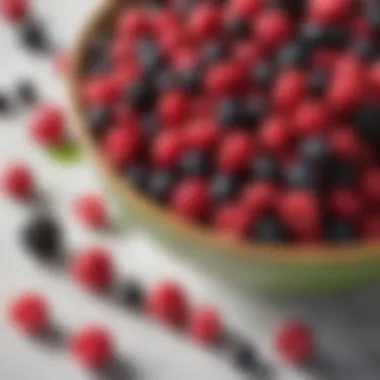High Cholesterol Remedies: Nutritional Focus for Heart Health


Intro
High cholesterol is often labeled a silent danger. Many individuals may not realize their levels are high until they undergo a health check. The heart, an essential part of survival, relies on good cholesterol management. Fortunately, a well-thought-out diet can make a significant impact. 🚀
With the right nutritional focus, you can navigate the complex landscape of dietary choices and blend pleasure with healthy living. This guide looks to demystify the connection between what we eat and how it affects our cholesterol levels. By making informed food choices, you can put yourself on a path toward better heart health.
Research indicates that certain foods can either alleviate or aggravate cholesterol levels. By digging deeper into this subject, we can equip ourselves with the knowledge needed to manage high cholesterol effectively. The aim here is to provide not only insights into the foods to embrace but also practical applications for incorporating them into your daily meals.
Through an exploration of ingredients, recipes, and cooking techniques, this piece aims to empower home cooks and food aficionados alike. The culinary world is full of robust flavors that can be enjoyed without compromising health. So let’s roll up our sleeves and dive into the realm of flavors and health benefits!
Understanding Cholesterol
Understanding cholesterol is critical when tackling high cholesterol issues with a nutritional perspective. It sets the stage for everything that follows in this article. By grasping what cholesterol is, how it functions in the body, and its various types, individuals can empower themselves to make informed dietary decisions. This foundational knowledge influences dietary choices and helps individuals understand how specific foods can either exacerbate or alleviate cholesterol-related concerns.
What is Cholesterol?
Cholesterol is a waxy substance that the body needs to build cells and produce hormones. While we often hear about its adverse effects, cholesterol itself is essential for various bodily functions. It is produced naturally by the liver but can also be obtained from food sources, particularly animal products. However, not all cholesterol is created equal, which brings us to understanding the different types that exist.
Types of Cholesterol
Cholesterol comes in several forms, primarily differentiated by their density and role in health. Among these, LDL, HDL, and triglycerides are the most significant. Let's delve into each of them:
Cholesterol
Low-Density Lipoprotein (LDL) cholesterol is often labeled as the "bad" cholesterol. This characterization arises from its tendency to contribute to plaque buildup in the arteries, potentially leading to cardiovascular diseases. That being said, it's vital to recognize that not all LDL is inherently harmful. Studies suggest that smaller, denser LDL particles are more damaging than larger, fluffier particles. Therefore, the focus should be on reducing the overall number of harmful particles while maintaining heart health. LDL plays a pivotal role in cholesterol management, making it a key consideration throughout this article.
HDL Cholesterol
Contrarily, High-Density Lipoprotein (HDL) cholesterol is known as "good" cholesterol. It assists in transporting cholesterol away from the arteries and back to the liver, where it is either broken down or passed out of the body as waste. A higher level of HDL is often associated with lower heart disease risk, which is why it is essential to integrate foods that encourage its production into your diet. Foods rich in healthy fats—like those found in avocados and olive oil—can help elevate HDL levels, making them ideal choices.
Triglycerides
Triglycerides are a type of fat found in the blood. When we consume more calories than we burn, the excess calories are turned into triglycerides and stored in fat cells. Having high levels of triglycerides may also contribute to the risk of heart diseases, similar to high LDL levels. Foods that promote high triglyceride levels are typically those high in sugar and refined carbohydrates, emphasizing the importance of moderation in diet. Keeping triglyceride levels in check is vital for maintaining an optimal cholesterol profile.
Risks of High Cholesterol
High cholesterol levels can lead to significant health risks, including heart disease, stroke, and other cardiovascular complications. Lodge your attention here: the effects of high cholesterol often go unnoticed until serious health issues arise. Regular check-ups, understanding food choices, and recognizing the balance needed among different types of cholesterol can drastically change one's risk profile.
In summary, a clear understanding of cholesterol, its types, and their roles in overall health is a stepping stone to making informed dietary choices.
By navigating the dynamics between LDL, HDL, and triglycerides, individuals can take actionable steps toward managing their cholesterol levels effectively.
The Role of Diet in Cholesterol Management
When it comes to managing cholesterol levels, diet plays a pivotal role. The choices we make at the table can either bolster our heart health or tip the scales towards complications. Hence, understanding this connection can significantly impact overall well-being. A nutrient-rich diet not only addresses high cholesterol but can also enhance quality of life. Eating well is not merely a task; it's an art that, when mastered, can become a pleasurable part of daily life.
Connection Between Food and Cholesterol
Our food choices influence cholesterol levels more than many realize. Each bite we take carries with it an array of nutrients that interact with our body in unique ways. Foods rich in saturated fats typically contribute to higher LDL cholesterol, the kind often termed "bad" cholesterol due to its role in arterial plaque buildup. Conversely, items laden with soluble fiber can help lower cholesterol by binding to bile acids in the intestine, prompting our bodies to use existing cholesterol to make more bile.
For instance, oats, barley, and beans are outstanding sources for these fibers, acting like tiny sponges absorbing excess cholesterol. It's worth noting that not all dietary approaches are one-size-fits-all. Understanding your unique responses to different foods helps tailor a more effective strategy for cholesterol management.
The Importance of a Balanced Diet
A balanced diet is like a well-orchestrated symphony. Each food group plays its part, contributing to a harmonious result for health. Including a variety of food ensures that you're not just consuming empty calories. For heart health, aiming for a mix of fruits, vegetables, whole grains, lean proteins, and healthy fats is essential. This blend not only provides essential nutrients but also helps in regulating cholesterol levels.
Key points on achieving a balanced diet:
- Fruits and Vegetables: Aim for a colorful plate. Dark leafy greens, berries, and citrus fruits pack a punch of vitamins that can aid cholesterol management.
- Whole Grains: Foods like quinoa and brown rice provide fiber and nutrients that promote cardiovascular health.
- Lean Proteins: Meats such as fish, particularly fatty types like salmon and mackerel, are high in omega-3 fatty acids, which can actually lower triglycerides and improve HDL cholesterol.
Cultivating a balanced diet demands not only knowledge but consistent mindfulness about the foods we consume.
"Eating with awareness—taking time to take notice of what you're eating—can be a simple yet significant step toward better health."
Beneficial Foods for Cholesterol Control
High cholesterol can be a real nuisance, but understanding how certain foods can help you manage it is a solid first step on your journey to better health. Foods that target cholesterol levels not only make your meals more nourishing but also help keep your heart happy. In this section, we’ll explore specific categories of beneficial foods with an eye on their contributions and unique features. This knowledge arms us with the ability to make informed choices when filling our shopping carts.
Soluble Fiber Sources
Incorporating soluble fiber into your diet is like pulling a rabbit out of a hat when it comes to cholesterol management. Soluble fiber helps reduce LDL cholesterol levels by binding to cholesterol in the digestive system and facilitating its removal from the body. The foods rich in this fiber keep your heart robust while also improving blood sugar levels.
Oats
Oats are often celebrated as a breakfast champion, and rightfully so. Their high beta-glucan content, a type of soluble fiber, lends its hand to lowering harmful cholesterol. This unique feature means that when you eat those warm oats in the morning, you're not just filling your belly; you're actively working toward your health goals. A slight misstep is their carb content, which might concern some in the keto community, but for many, the heart benefits overshadow this drawback. Oats offer an easy-to-prepare option without sacrificing flavor.
Barley
Barley is a bit of an underdog in the grain family, but it packs quite a punch. Its significant soluble fiber content makes it a powerful player in reducing cholesterol levels. It's also chewy and brings a unique taste to soups and salad dishes, enhancing your meals with a nutty flair. An important thing to note is that it might not be everyone's cup of tea regarding texture, but its heart-health benefits can’t be overlooked.
Beans


Beans are another remarkable source of soluble fiber and deserve a special mention. Whether it's black beans, kidney beans, or chickpeas, they not only help in cholesterol control but also deliver protein, making them a great meat substitute. The grand advantage of beans is their versatility; toss them in soups, salads, or even desserts. Yet, some folks struggle with digestion when it comes to beans. It’s often advised to introduce them gradually into your meals to avoid any discomfort.
Healthy Fats
When managing cholesterol, many assume that fats are the enemy. However, this notion needs some reframing. Healthy fats can actually facilitate better cholesterol balance, promoting heart health. Distinguishing these beneficial fats from their unhealthy counterparts is essential when deciding what to include on your plate.
Avocado
Avocado is often described as a creamy delight that’s simply delicious. This rich fruit is loaded with monounsaturated fats, known to elevate HDL (the good cholesterol) while simultaneously lowering LDL (the bad cholesterol). It’s a standout because it can easily fit into a variety of dishes: think salads, smoothies, or even toast. However, calories do add up, so enjoying this powerhouse in moderation is wise.
Olive Oil
Notably famed for its health benefits, olive oil is celebrated in many diets, especially the Mediterranean. This oil is high in oleic acid, a monounsaturated fat that helps reduce the risk of heart disease. Splashing a bit on your veggies or using it in salad dressings not only adds flavor but works towards better cholesterol levels. Some, however, might find it a bit heavy in cooking as deep-frying is not recommended.
Nuts
Nuts, a small but mighty dietary addition, are often seen as nature’s little nuggets. Almonds, walnuts, and pistachios are all excellent choices. Their healthy fats are excellent in cholesterol management, packed alongside various nutrients. One unique aspect is their crunchy texture, which can add an interesting element to meals. Watch out for portions, as nuts can be calorie-dense, but small amounts can pack a powerful health punch.
Fruits and Vegetables
When it comes to fruits and vegetables, variety truly is the spice of life. Their natural compounds aid in lowering cholesterol and promoting overall health. They are colorful, vibrant and can easily be integrated into daily meals.
Berries
Berries come in all sorts of colors and sizes and can do wonders for your heart health. Loaded with antioxidants, particularly soluble fiber, they help reduce bad cholesterol levels. Their sweet-tart flavor is a delightful addition to smoothies, yogurt, or simply as a snack. An interesting point to note is that they are relatively lower in sugar compared to processed snacks—an added bonus that makes them popular.
Cruciferous Vegetables
Broccoli, kale, and Brussels sprouts fall under the umbrella of cruciferous vegetables and are packed with nutrients. These veggies not only help detoxify the body but also provide significant aid in managing cholesterol. They are versatile, too, and can be roasted, steamed, or eaten raw in salads. One downside might be the strong flavor, which isn’t for everyone, but their health benefits are undeniable.
Citrus Fruits
Oranges, lemons, and grapefruits are not just refreshing; they are also beneficial in lowering cholesterol. Rich in vitamin C and fiber, they help improve heart health. One unique quality is their ability to enhance the flavors in dishes, bringing a spark of brightness to meals. However, some individuals might be cautious about the acidity if they have a sensitive stomach.
Plant Sterols and Stanols
Not commonly known, plant sterols and stanols are naturally occurring substances that can help reduce cholesterol absorption in the gut. These compounds, found in vegetable oils, nuts, seeds, and fortified foods, can decrease LDL levels. Having a diet rich in these compounds may be a significant part of your cholesterol management plan.
Fatty Fish
Fatty fish is a true champion in the battle against high cholesterol. Its omega-3 fatty acids contribute significantly to heart health. Just a couple times a week can make a marked difference in cholesterol levels and overall heart function.
Salmon
Salmon is both tasty and packed with omega-3 fatty acids. Not only does it help lower LDL cholesterol, but it also supports mental health and cognitive function. Choosing wild-caught salmon is often recommended due to its higher nutrient content, but farmed options are still beneficial. Its distinct flavor and versatility—baked, grilled, or smoked—makes it a top choice among fish lovers.
Mackerel
Mackerel is another excellent source of omega-3s. This fish has a rich flavor that many enjoy, making it a fantastic addition to various meals. It’s also notably high in selenium, which plays a role in metabolism and thyroid function. An aspect to consider is the oil content, which can lead to a heavy meal, so pairing it with lighter sides can balance things out.
Sardines
Sardines are often ignored in grocery aisles but are packed with benefits. They're high in omega-3s, vitamin B12, and calcium. Their convenient size makes them easy to include in sandwiches, salads, or pastas. On the flip side, they can have a strong fishy taste, and not everyone is fond of them. Yet, once folks give them a chance, they often find them both nutritious and satisfactory.
Foods to Limit or Avoid
To effectively manage high cholesterol levels, the foods we limit or totally avoid play a crucial role. Ignoring the ramifications of unhealthy dietary choices can lead to detrimental health outcomes, particularly for the heart. Swapping out specific items can mean the difference between a healthy lifestyle and a worrying health scenario. In this section, we’ll explore three major categories of food that are best kept in check: trans fats, saturated fats, and processed foods with added sugars.
Trans Fats
Trans fats are notorious for their negative impact on cholesterol levels. These fats are formed during a process called hydrogenation, which turns liquid oils into solid fats. While they may improve the texture and shelf life of processed foods, the health risks far outweigh the benefits. Consuming trans fats raises low-density lipoprotein (LDL) cholesterol—often referred to as "bad cholesterol"—while simultaneously lowering high-density lipoprotein (HDL) cholesterol, which is the "good cholesterol" necessary for heart health.
Foods high in trans fats include:
- Margarines: Especially those that are stick-like or specifically labeled as hydrogenated.
- Fried Foods: Items such as French fries and doughnuts typically contain significant trans fats.
- Baked Goods: Commercially made cakes, cookies, and pastries often yield an ample amount of these unhealthy fats.
Given the clearer connection between trans fats and heart disease, the best course of action is to eliminate them from your diet completely.
"When it comes to your heart, choosing wholesome whole foods over processed fare is the way to go."
Saturated Fats
Saturated fats come primarily from animal sources, such as red meat and full-fat dairy products, and can also be found in certain tropical oils like coconut and palm oil. These fats have been shown to raise levels of LDL cholesterol in the blood, increasing the risk of cardiovascular diseases. That's why moderating saturated fat intake is highly advised for those managing their cholesterol.
Common sources to be mindful of include:
- Fatty Cuts of Meat: Think steak, sausage, and lamb.
- Full-Fat Dairy: Cream, butter, and certain cheeses can dish out a hefty dose of saturated fat.
- Processed Snacks: Many snack foods, such as chips and certain commercial cookies, lurk with unhealthy levels of saturated fats.
Replacing these with healthier alternatives—like lean meats, low-fat dairy, or plant-based options—can drastically improve heart health and cholesterol levels.
Processed Foods and Sugars
Processed foods are laden with both unhealthy fats and sugars, making them a double whammy when it comes to managing high cholesterol. Often high in sodium, preservatives, and sugar, these foods tend to promote inflammation and weight gain, further exacerbating the risks associated with elevated cholesterol levels.


Watch out for:
- Sugary Drinks: Sodas and energy drinks can be loaded with hidden sugars.
- Packaged Snacks and Meals: These are often rich in unhealthy additives and trans fats.
- Candies and Desserts: They not only contain artificial ingredients but also empty calories.
When aiming for holistic health, it's smart to substitute processed foods with fresh fruits, whole grains, and batch-cooked meals. Not only does this approach support better cholesterol management, but it also lays the foundation for a more gratifying culinary journey.
In summary, being mindful of what you consume is key. The foods to limit or avoid are more than just dietary suggestions; they are implications for your health that warrant attention. Paying heed to these details can pave the way to a heart-healthy lifestyle.
Practical Cooking Strategies
Cooking strategies play a significant role in managing high cholesterol levels. By understanding how to prepare and combine foods, you can have a big impact on heart health. It’s not just about what you eat, but how you cook it. Simple changes in your kitchen habits can lead to healthier meals that keep cholesterol in check. Here’s a closer look at some effective techniques.
Replacing Ingredients
Alternative Cooking Oils
Choosing the right cooking oils can make a world of difference in your meals and overall health. Conventional oils, like those high in saturated fat, often contribute to elevated cholesterol levels. On the flip side, alternatives like olive oil or avocado oil not only impart flavor but also come packed with healthy monounsaturated fats. These fats can help lower bad cholesterol while boosting good cholesterol levels.
The unique aspect of alternative cooking oils is their heart-healthy properties, coupled with antioxidants found in them. For instance, olive oil is rich in oleic acid, a compound shown to have anti-inflammatory effects. It’s a beneficial choice in any kitchen focused on cholesterol management.
However, while these oils are healthier, it’s crucial to keep portions in check, as they are calorie-dense. Drizzling too much can negate benefits. Balancing quantity with quality is key in cooking.
Substituting Dairy
Dairy products can contain high levels of saturated fat, contributing to cholesterol issues. Substituting dairy is an effective strategy to enjoy creamy textures and flavors without the fat load. Plant-based dairy alternatives, such as almond milk or coconut yogurt, provide diverse choices.
One standout feature is the fortification of some non-dairy options with vitamins, especially B12 and Vitamin D, which are often lacking in strict plant-based diets. This makes them a popular choice for both health-conscious individuals and those wanting to reduce cholesterol.
Still, it's essential to review labels. Some alternatives can have added sugars or fats that might work against your goals. Always be mindful of ingredient lists.
Preparation Techniques for Healthy Meals
Grilling
Grilling is more than a popular way to prepare food; it allows fats to drip away from meats and vegetables, reducing calorie and fat content. When you grill, the high heat creates a wonderful char while you avoid the need for excessive oils or fats. Plus, the flavor becomes smokier, enhancing the taste experience.
The unique aspect of grilling lies in the preservation of nutrients. Vegetables grilled on a barbecue retain vital vitamins. It’s a beneficial cooking method that can also bring families together around a vibrant outdoor meal.
On the downside, charred meats may produce substances that are potentially harmful if consumed regularly, so balancing grilled meals with other cooking methods is advisable.
Steaming
Steaming is one of the gentlest cooking techniques, preserving most nutrients and keeping food light. Unlike boiling, steaming helps retain the color, flavor, and texture of foods, making it an attractive option for veggies like broccoli or carrots that are notorious for losing their appeal in overly cooked dishes.
The standout characteristic of steaming is how it avoids the need for butter or excessive spices, relying on the natural flavors. It's also a great option for cooking fish, which can help keep it flaky and moist without additional fats.
However, some argue that steaming can make foods appear less appealing, often lacking that appealing browning. Pairing steamed ingredients with vibrant herbs and spices can enhance presentation and appetite.
Baking
Baking doesn’t just apply to desserts; it's an excellent method for preparing meats and vegetables. This technique surrounds food with dry heat, which allows flavors to meld beautifully. Using minimal oils or fats can lead to healthy dishes that are still satisfying.
A key feature of baking is its versatility; you can create dishes ranging from roasted veggies to whole grain muffins that avoid high sugars and fats. This way, you can manage portions without sacrificing enjoyment.
However, when baking, portions can sometimes be challenging to gauge, especially with tempting options like baked goods, so being cautious with servings is necessary as sugary baked products can tempt even the best of us.
Meal Planning for Cholesterol Management
Meal planning is more than just deciding what to eat for the week. It can make a significant impact on managing high cholesterol, ultimately aiding in heart health. When individuals take the time to plan their meals, they gain control over their dietary choices, ensuring that each dish they prepare aligns with their health goals. The practice helps eliminate the temptation of impulsive decisions, which often lead to less nutritious options. By thoughtfully choosing ingredients and dishes in advance, one can easily incorporate beneficial foods while mitigating the intake of harmful ones.
The key elements of effective meal planning include understanding portion sizes, selecting a balance of macronutrients, and prioritizing whole foods. Incorporating a variety of colorful fruits and vegetables, lean proteins, and healthy fats not only adds flavor variety but also ensures all nutritional needs are met. This approach encourages diversity in one’s diet, which is essential for long-term adherence to healthy eating practices.
Furthermore, meal planning facilitates healthier snacking options, allows for bulk preparation and freezing, which can save both time and resources. This not only reduces food waste but also aids in managing cholesterol levels consistently over time. Overall, meal planning brings a sense of commitment and motivation to make enduring lifestyle changes that benefit heart health.
Weekly Meal Ideas
When it comes to meal planning for cholesterol management, having a few tried-and-true recipes on hand can make the week much easier. Here are some ideas for meals spread across seven days:
- Breakfast Options:
- Lunch Ideas:
- Dinner Selections:
- Snack Suggestions:
- Overnight oats topped with fresh berries and a spoonful of almond butter.
- Whole grain toast with smashed avocado and poached egg.
- A smoothie made with spinach, banana, and flaxseed.
- Quinoa salad with black beans, chopped bell peppers, and a hint of lime.
- Grilled chicken wraps using whole grain tortillas and lots of lettuce.
- Lentil soup seasoned with herbs and spices, served with a side of whole grain bread.
- Baked salmon with roasted Brussels sprouts and quinoa.
- Stir-fried tofu with a medley of vegetables served over brown rice.
- Grilled shrimp tacos topped with cabbage slaw and avocado.
- A handful of mixed nuts or seeds.
- Hummus with carrot and cucumber sticks.
- Greek yogurt with sliced peaches or a touch of honey.
By having meals organized like this, it becomes easier to make healthier choices and adhere to a lower cholesterol diet.
Snacking Wisely


Snacking plays a crucial role in how one maintains energy levels and manages cholesterol. Not all snacks are created equal, and while it might be tempting to grab that bag of chips or candy bar, opting for heart-healthy choices can significantly support your cholesterol goals.
Here are some smart snacking strategies:
- Choose Whole Foods:
- Incorporate Protein:
- Limit Processed Snacks:
- Fresh fruits such as apples, bananas, and berries are great choices, offering natural sweetness alongside fiber.
- Raw vegetables, like bell peppers or cherry tomatoes, can satisfy crunch cravings while providing nutrients.
- Snack on nuts, seeds, or nut butters for a dose of healthy fat and protein. However, moderation is key since they are calorie-dense.
- Greek yogurt is a fantastic option, offering protein and probiotics, contributing to digestive health.
- Avoid processed snacks that often contain trans fats, added sugars, and sodium. These can derail your efforts to manage cholesterol.
By making conscious decisions about what and when to snack, you can add positive fuel to your body, all while keeping those cholesterol levels in check.
"Meal planning and mindful snacking can create a path towards lasting health improvements while keeping your culinary experiences enjoyable."
By following these guidelines, anyone can enhance their meal planning skills while savoring the flavors of nutritious foods.
Monitoring and Adjusting Your Diet
Keeping an eye on what you eat ain’t just a smart move. It's essential, especially when it comes to managing high cholesterol. The foods you choose play a significant role in your overall health and cholesterol levels. Thus, monitoring your diet helps you identify areas of improvement and reinforces mindful eating habits. Plus, adjusting your diet isn’t about deprivation. It's more about discovering delicious alternatives that can benefit your heart while still treating your taste buds.
Understanding Food Labels
When shopping, food labels can either be your best friend or your worst enemy. They provide a wealth of information you can’t afford to overlook. Learn to read these labels more like a detective unraveling a mystery, focusing on specific details that impact your cholesterol. Here are some key elements to pay close attention to:
- Total Fat: Look for products with lower total fat content. Even better, select items that highlight healthier fats.
- Saturated Fat: You want this number to be low, aiming for less than 7% of your total daily calories from saturated fats. This means steering clear of tropical oils or high-fat dairy, often lurking in processed foods.
- Trans Fats: This is the real bad guy; ideally, you want it at zero. Read "Partially Hydrogenated Oils” on the label and steer clear—those are the sneaky culprits behind raised LDL levels.
- Cholesterol Content: Products claim to be heart-healthy should have less than 300 mg of cholesterol per serving.
- Fiber Content: Target foods that are high in soluble fiber, which can help in lowering LDL cholesterol. If it comes with at least 5 grams of fiber per serving, you're onto something good.
"Turning the label over can help turn your cholesterol numbers around."
Getting comfy with these details will empower you to transform grocery shopping from a mundane task to a valuable health investment.
Tracking Cholesterol Levels
Your dietary changes won’t make an impact if you don’t keep tabs on your cholesterol levels. Regular tracking not only gives insights into how well your dietary choices are working but also motivates you to keep pushing forward. Here’s how you can effectively monitor your cholesterol levels:
- Regular Check-Ups: Schedule regular check-ups with your healthcare provider. Aim for at least once a year or more frequently if you have risk factors or a family history of high cholesterol.
- Use Cholesterol Monitors: Consider home cholesterol tests available in pharmacies. These can offer a snapshot of your levels. Just ensure they are FDA-approved for reliability.
- Document Your Changes: Keeping a journal of what you eat alongside your cholesterol levels can unveil patterns. You might see positive results after a week of swapping out red meat with fish or adding more fruits and veggies to your plate.
- Engage with Community: Join online forums like those on Reddit or Facebook groups dedicated to nutrition and health. Exchanging experiences or tips on managing cholesterol provides both support and encouragement.
In essence, monitoring your diet and cholesterol is no solo act. It’s a collaborative effort between you and healthcare professionals. Remember, every small change counts, bringing you closer to a healthier heart.
Consultation with Healthcare Professionals
When embarking on the journey to manage high cholesterol, the role of healthcare professionals can't be overstated. Consulting with doctors, dietitians, or certified nutritionists is crucial. They bring the expertise and knowledge necessary to design a personalized strategy for diet and lifestyle changes. This journey isn’t just about altering what you eat; it’s about understanding how those changes affect your overall health and addressing specific needs.
The Importance of Professional Guidance
Professional guidance isn’t just a nice-to-have; it’s a fundamental part of cholesterol management. Healthcare professionals can help ascertain individual cholesterol levels and identify your specific risks. They can provide insights rooted in medical science, which ensure that dietary changes align with your health goals.
A dietitian might suggest incorporating more soluble fibers like oats or beans into your meals, while also considering any other health conditions you may have. Are you diabetic? Do you have a gluten intolerance? These factors play a significant role in shaping your dietary approach.
Moreover, personalized guidance can provide motivation and accountability. With a professional in your corner, it’s easier to stay committed to dietary changes. They will not only offer recommendations but also educate you on reading food labels, balancing meals, and even meal prepping. This early touchpoint can ultimately ensure you're not navigating these changes in isolation; it’s a partnership for better health.
Integrating Diet with Medications
For many, managing cholesterol levels may involve medication such as statins. But the process doesn’t merely stop with a prescription; it’s imperative to integrate dietary changes with your medicinal regimen. A healthcare professional can help discern how dietary adjustments can complement medication, potentially enhancing its effectiveness.
For instance, certain foods can interact with medications, either elevating or diminishing their effect. Grapefruit, while healthy in moderation, can affect how statins work, leading to complications. Thus, having conversations with your healthcare provider about food interactions is essential. You'll also want to inquire about timing—when to take your medicine in relation to mealtime to maximize its impact.
"Consulting with healthcare professionals ensures both your dietary choices and medications are in sync, enhancing your overall strategy for managing cholesterol."
To make the most of these interactions, consider preparing specific questions in advance. Before meetings, jot down any concerns and note your dietary patterns. Taking this proactive approach can lead to more fruitful discussions. This way, you’re not just passively receiving advice, but actively engaging in a dialogue to optimize your health outcomes.
Closure
As we draw this exploration of high cholesterol remedies to a close, it's vital to take stock of the myriad dietary strategies we've discussed. High cholesterol is a condition that affects many, yet understanding the nutritional landscape can serve as a powerful tool in managing it. Each food choice carries weight, from the beneficial fibers enriching your diet to the unhealthy trans fats that can sneak into seemingly harmless meals.
When you summarize the key points from our discussion, several important elements emerge. Firstly, certain foods like oats and fatty fish are strategically valuable for controlling cholesterol levels due to their inherent health properties. Secondly, the balance of what to avoid is equally crucial—whether it's steering clear of processed snacks or dodging excessive saturated fats, being informed is half the battle. Thirdly, the integration of cooking strategies, such as grilling or steaming, can make a world of difference in food preparation, effectively enhancing meal quality while supporting heart health.
"Education is the most powerful weapon which you can use to change the world."
- Nelson Mandela
In recognizing these elements, we carve a path towards better heart health. This doesn’t merely involve a single dietary overhaul, but rather an ongoing commitment to understanding the intricate relationship between what we eat and our body's response.
Summarizing Key Points
To revisit the takeaways:
- Incorporate Beneficial Foods: Emphasize soluble fibers from sources like oats and beans, while making fatty fish a staple.
- Mind the Avoidance List: Reduce intake of trans fats and limit processed foods to safeguard cholesterol levels.
- Cooking Techniques Matter: Opt for healthier preparation methods such as steaming and grilling that maintain the integrity of nutrients in the food.
By keeping these points at the forefront of your culinary decisions, you establish a more harmonious relationship with food, paving the way for improved health outcomes.
Encouragement for Continuous Learning
The journey doesn’t end here. Continuous learning about nutrition can be quite advantageous. The world's food landscape is always evolving; new research emerges that might refine our understanding of cholesterol and heart health. Engaging with credible sources, whether it's reading up on recent studies from sites like Wikipedia or participating in discussions on platforms like Reddit, can enrich your dietary knowledge.
Furthermore, consider exploring different cuisines and their unique approaches to ingredients. For instance, Mediterranean cooking, rich in vegetables and healthy fats, is not just delicious but is also well-studied for its heart health benefits. Adapt these principles into your own kitchen; this isn’t about rigid rules but rather about forming a responsive culinary practice.
Ultimately, arming yourself with information about high cholesterol and nutrition not only enhances your culinary experience but also lays the foundation for a healthier life. As with any learning, embrace curiosity and evolve continuously, making informed choices along the way.







